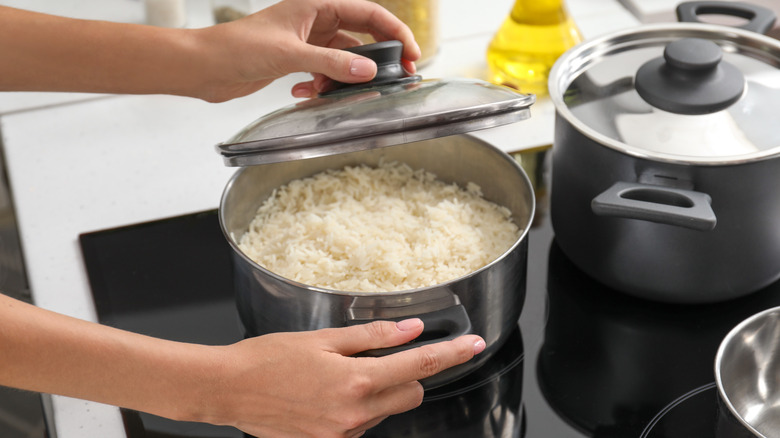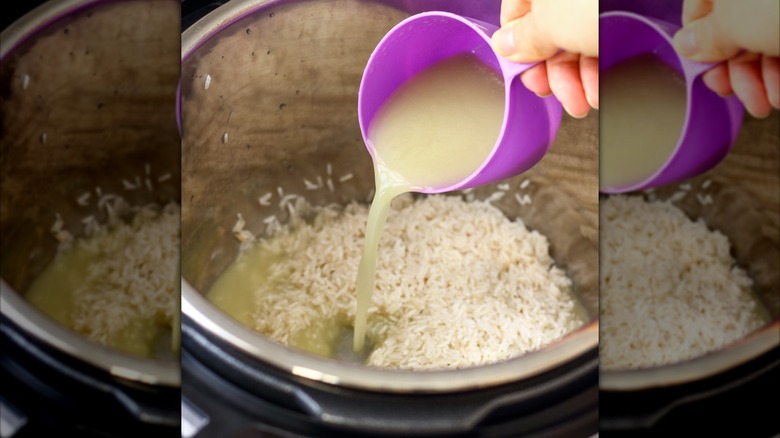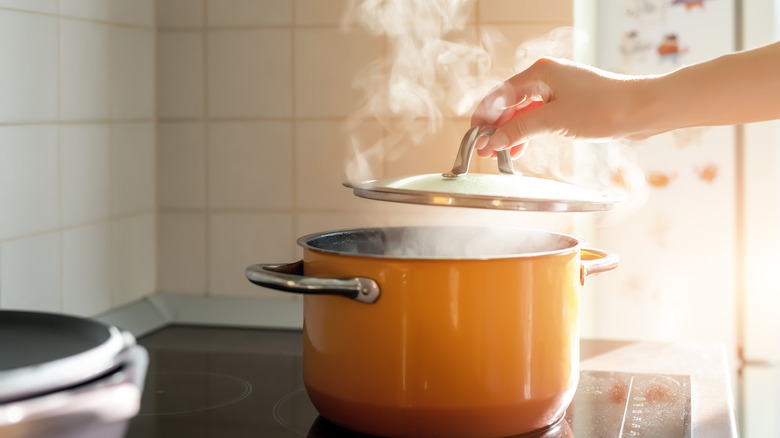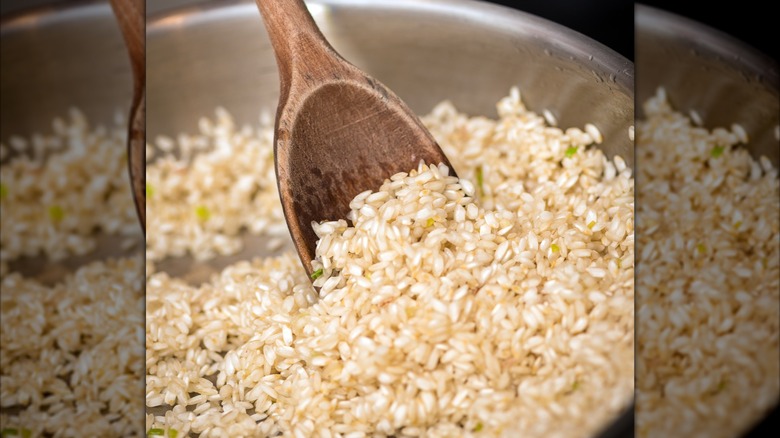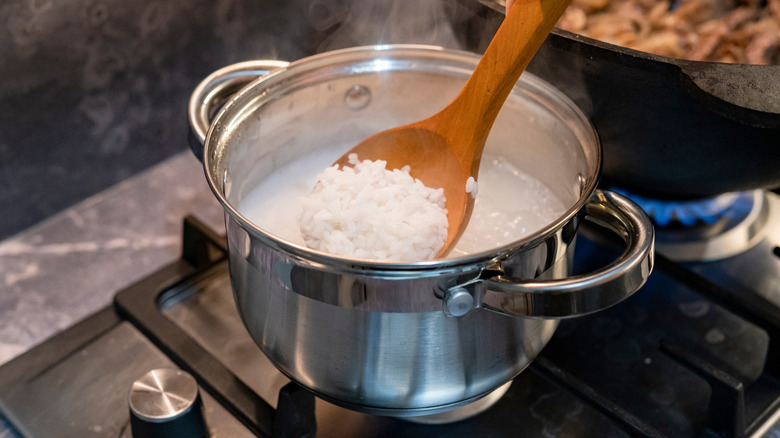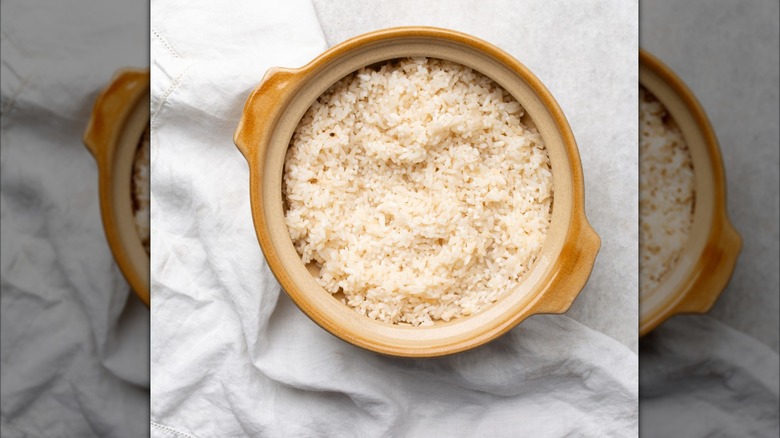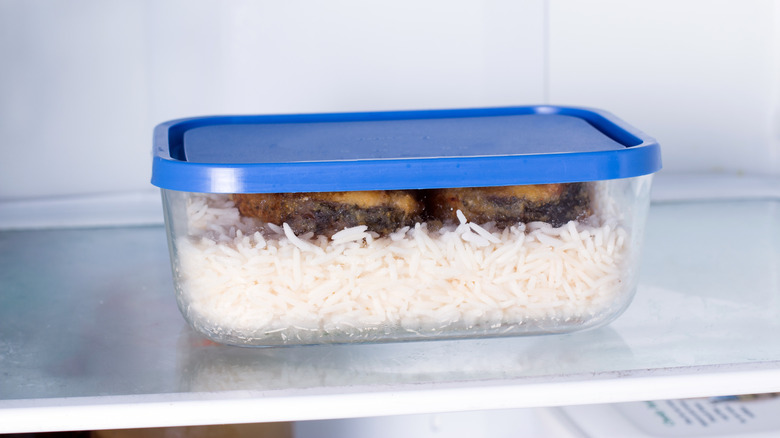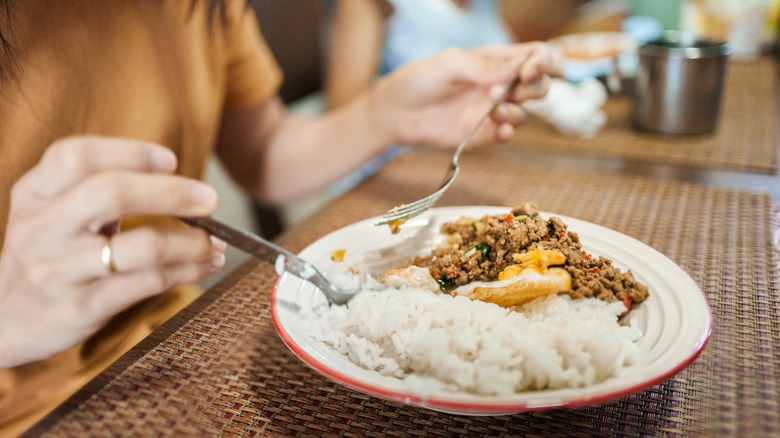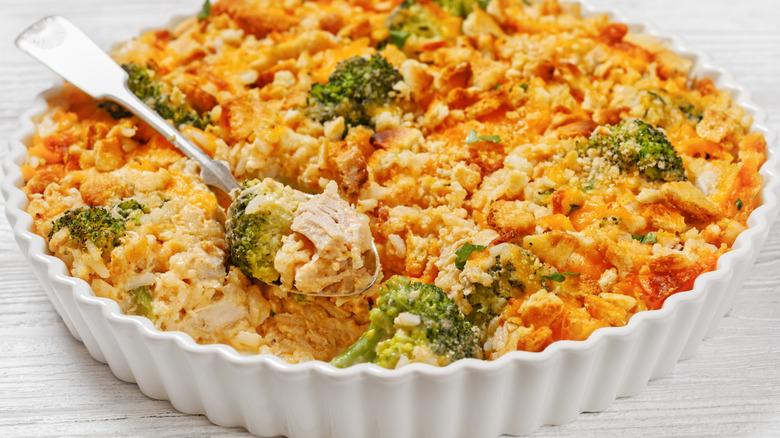The Biggest Mistakes People Make When Cooking Rice
Rice seems ultra-simple on the surface, and it's clear why it's a staple among so many cultures — it's versatile, easy to incorporate into just about any meal, often affordable, and both filling and reasonably nutritious. However, anyone who's ever struggled to strike the right balance between mushy and crunchy rice will tell you: While rice is straightforward, cooking it is not.
If you manage to find a rice recipe and formula that works for you, you'll likely make rice the same way over and over again. Once you really nail it, the process becomes foolproof and even easy. However, getting there can take a lot of trial and error. You can limit those trials and errors a bit, though, by learning from the mistakes of others. These are some of the biggest mistakes the average person makes when cooking rice, so you can avoid them the next time you have a hankering for a side of rice and beans, a pot of jambalaya, some stuffed peppers, or however you choose to eat this delectable grain.
Not rinsing your rice
Rinse the rice. Don't rinse the rice. You've probably heard varying arguments from both camps. However, if you find that your rice dishes frequently come out gummy, then you need to start taking the extra step to rinse your rice, stat. Rinsing rice removes a starchy exterior layer from the grain. When you cook rice, this starch can stick together, basically forming a nasty glue. Remove the starch, and you lower your chances of your rice turning into a globby mess. Some varieties of rice contain higher levels of sticky starch than others. Arborio rice and sweet rice are two of these, so they may need to be rinsed more than others.
Additionally, even if you're not worried so much about starch — perhaps you buy one of the types of rice that are less prone to starch stickiness, like basmati and jasmine rice — rinsing the rice is still a good idea in general. It's an agricultural product just like dried beans or lentils, and giving the rice a rinse can ensure you're washing away any foreign objects that would've made their way into the packaging.
Not using the correct liquid-to-rice ratio
Pull up five different recipes for rice and you're likely to get five different takes on the correct liquid-to-rice ratio. If you're not using a recipe, you might even decide to eyeball your liquid-to-rice ratio. That, however, is one of the simplest rice mistakes that you can most easily avoid.
The liquid-to-rice ratio is going to be the difference between undercooked rice, burnt rice, or oh-so-perfect fluffy rice. The ratio you choose also depends on the rice type, as well as your cooking method. In near-perfect cooking conditions, like in a well-functioning rice cooker, short-grain and jasmine rice can be cooked at a ratio of 1-to-1 rice-to-liquid, while long-grain rice will need a 1-to-2 rice-to-liquid ratio. Brown rice may need even more liquid, at a 1-to-3 rice-to-liquid ratio. However, when you account for evaporation, loose pan lids, and similar factors at play when cooking on the stovetop or anywhere else beyond the carefully crafted confines of a rice cooker, you may find that you'll need more water overall, and you might want to start at a 1-to-2 rice-to-liquid ratio, just to be safe.
Lifting the lid too often
It's one of the most common mistakes that new cooks make in the kitchen. You're simply so eager to see what's happening under that lid that you can't stop lifting it, just to see what's going on. Is the rice cooking? Is the water even boiling? Is all the water gone, and is your rice now burning? Who knows what's going on under that mysterious lid! It's the same impatience that tells eager home cooks to flip the steak on the grill far too soon, interrupting the charring process, and the same impatience that needles baby bakers to open up the oven door to take a quick peek. It won't hurt anything, surely!
But actually, it will. Don't jump the gun when cooking your rice and begin lifting that lid up too soon and too frequently. All that evaporated water needs to be contained in order for your rice to cook properly. When you let the steam escape, you interrupt the cooking process, and it's less likely that your rice will cook correctly or in a timely manner. So, know how long the rice should reasonably take, start cooking, and don't lay a finger on that lid.
Not flipping your rice
Okay, okay, we just told you not to lift that lid too often when you're cooking rice. However, if you really can't help yourself, there is one trick you can try that might actually help your rice rather than harm it — and it's a trick worth trying even if you don't have a lid-peeping problem.
In a prior Takeout article, Executive Chef Abreu of Boston's Vela Seaport and Deck 12 said his secret to achieving perfectly cooked rice is to uncover the rice every five minutes for a quick flip. This ensures the heat is being distributed evenly, so you avoid a fluffy, well-cooked top layer of rice, followed by a burnt, sticky mess glued to the bottom of your pot.
However, do note that Abreu recommended that you specifically flip the rice. You absolutely shouldn't stir the rice, as that can encourage the rice to release starch, which can make for some sticky business. Instead, using a spatula, literally flip the rice over from the bottom in one single motion. Then put that top back on the pot and mind your business until it's time for the next flip in five minutes.
Only cooking your rice on the stove
So maybe you've experimented with various rice-to-water ratios. Maybe you've rinsed your rice. Maybe you've tried both flipping your rice and leaving it completely alone for the duration of the cooking time. And through all this, you still can't seem to conquer cooking rice on the stovetop.
If this scenario sounds familiar, it's time that you abandon the stovetop for the oven. A much easier, hands-off cooking method for rice, it's a tried-and-true option for those who struggle to cook rice any other way. Using a 1-to-2 rice-to-liquid ratio, pour your desired amount of long-grain rice into the bottom of a square casserole dish. Meanwhile, heat your liquid (go with broth rather than water, for more flavor) on the stovetop until boiling. Pour the boiling liquid onto the rice, toss in half a stick of butter, and cover tightly with aluminum foil, making sure that no steam is escaping. Pop the dish in a 375-degree oven for 30 minutes, and you'll be on the road to perfectly fluffy, not-at-all gummy rice.
Cooking all rice the same way
You've probably caught on by now that you shouldn't be cooking all rice the same way. Often, short-grain rice requires the least amount of cooking liquid, long-grain rice requires a little bit more, but both have similar cooking times. Brown rice, meanwhile, requires much longer cooking times and significantly more water.
Long-grain rice, as mentioned, doesn't have quite the tendency to clump up as short-grain rice does, and so it's a great pick if you're making a dish that really relies on your rice having more of a light texture, such as salads or side dishes wherein you'll be eating the rice relatively plain. Short-grain rice, in contrast, can be used in places where its stickiness can be a pro rather than a con, such as in sushi or some desserts. Medium-grains like Arborio sit in the middle and can be chewy and creamy without going full-on-clump, making them ideal for dishes like risotto and arancini. Then, of course, you can get into more niche types of rice, like red rice and black rice, which have longer cooking times, similarly to brown rice. Knowing what type of grain you're cooking with ahead of time will help narrow down the appropriate cooking method for a perfect pot of rice.
Not adding salt to your rice while cooking
It's a common misconception that you shouldn't add salt to your rice while cooking it, but there's really no definitive reason why this rule exists. It could be that, historically, in many cultures wherein rice is prominent, it would be served with other salty foods, so it simply didn't need any extra. However, these days, if you want to add salt to your rice while cooking it, go right ahead. Of course, again, this may be pointless if you're cooking your rice in a salty liquid like broth, but if you're only using plain water, you may find the salt gives you an added boost of flavor.
Adding salt to your cooking water for rice isn't the only way that you can mimic pasta techniques when it comes to cooking rice, though. If you're still struggling with your rice-to-water ratios, you may just take the pasta approach to cooking this grain: Use way more water than you need, without the expectation that the rice is going to soak it all up. Instead, cook the rice at a rolling boil (just like you would pasta), and when it's done (which you can test for by just grabbing a spoon and taste-testing), strain it.
Choosing the wrong cooking vessel
There are a few things to look for when picking a cooking vessel for your rice. You don't want to just grab any ol' pot or pan from the pantry.
Obviously, when cooking rice on the stove, you're going to need a pot with a tight-fitting lid. The steaming process is just as important as the boiling, helping you achieve just the right rice texture, so you need to retain that steam as much as you can. If your lid doesn't fit as tightly as you'd like, and you suspect quite a lot of steam is leeching out, you can cover the cooking rice with a layer of aluminum foil before placing the lid on top.
Cast iron, somewhat surprisingly, is a favorite for cooking rice, thanks to the material's even heat distribution. However, cast iron, as beloved by many as it is, does come with downsides, such as the extra care it requires. While they similarly require extra care, a Japanese ceramic pot known as a donabe is likewise a top pick for rice. If you don't have either of those at your disposal, a standard metal pot will suffice.
Not letting cooked rice sit
You used the proper ratio of water to rice. You picked the right cooking time for your particular type of rice. You were careful not to lift the lid throughout the cooking process, and even if you did, it was just to give those grains an oh-so-gentle flip. The oven timer's just buzzed, so it's time to turn off the heat. Your rice should be cooked and you're ready to eat... right?
Not so fast. You still have room to make a major mistake. If you don't allow the rice to sit, lid on, heat off, you're missing an important step. Waiting just 10 minutes more can allow your rice to fully steam and absorb any last bit of moisture, making for fluffier, overall better rice. However, you may find that once you do remove the lid, excess condensation drips down off the lid and onto your rice, ruining the texture of at least a small portion of the rice. If this has been your experience, as soon as you turn off the burner, place a clean kitchen towel between the pot and the lid, and then let it sit that way for the allotted 10 minutes, like normal. The towel will soak up the condensation from the lid while the rice continues to steam.
Incorrectly storing your rice
If you're not chronically online, you may've missed the hullabaloo on TikTok in 2024, when influencers began telling us that we were all going to die from eating leftover rice. Those types of statements were a little bit overblown. Yes, it is true that incorrectly storing your rice can have severe health consequences; however, storing your rice the right way to avoid these consequences is incredibly easy.
A type of bacteria called Bacillus cereus can be found in rice, as well as other starchy foods like pasta and potatoes. This bacteria isn't killed by cooking or digestion, and while consuming it is generally safe at small levels, it's not if the bacteria multiply, which it does quickly when rice is left out at temperatures of 40 to 140 degrees Fahrenheit.
Luckily, all you have to do to properly store your leftover rice is make sure that your leftovers end up in the fridge within two hours of cooking (ideally within one). Or, if you're keeping rice on a "warm" setting like that on a rice cooker, the temperature is kept above 150 degrees Fahrenheit.
Failing to correctly reheat your rice
Whenever you get ready to eat your leftover rice, you can take further steps to avoid potential food-borne illness. Rice that's been stored in the fridge should be eaten within four to six days. If you freeze your cooked rice, it'll last up to six months. When you are ready to reheat the rice, make sure to reheat it to at least 165 degrees Fahrenheit throughout the entire serving. Don't just toss it into the microwave for a few minutes and call it "good enough," even though there are a few cold patches (the temptation may be there to stir the hot and cool rice together and chow down, but your body will thank you for not risking it).
Reheating rice does come with some of its own challenges, though, as the wrong reheating method could leave you with a dried-out, tough grain. For best results, reheat the rice on the stovetop, with a lid, adding a bit of extra water to prevent dryness.
Not repurposing leftover rice
Don't just eat your leftover rice the exact same way you originally cooked it. You can repurpose leftover rice in tons of ways, for brand new dishes in the days following cooking up a big batch.
The most obvious option is to make fried rice, which requires leftover rice to begin with. Rice pudding is another no-brainer. However, go a little bit outside the box by using leftover rice in stuffed peppers, casseroles, or soup. You don't even need a recipe. For a leftover rice casserole, just combine your rice with the protein of your choice, some canned or frozen vegetables, and a creamy base like a condensed cream-of soup, covering it all with cheese and a crunchy topping. For leftover rice soup, do much the same, with your broth of choice, a protein, and vegetables. You can also meal prep some burritos, freezing them for later use, or you can use leftover rice as a binding ingredient in meatballs or meatloaf.
